Analysis: Russian army Armored vehicles Air defense systems Missile systems at Victory Day parade 2020
Analysis by Army Recognition editorial team of the combat vehicles, APC Armored Personnel Carriers, IFV Infantry Fighting Vehicles, MBT Main Battle Tanks, air defense vehicles, and missile systems showcased by the Russian army at the Victory Day military parade of the Russian armed forces that took place on Red Square in Moscow, on June 24, 2020. This parade celebrated the 75th anniversary of the Allied victory against Nazi Germany in 1945. On this occasion, the Russian army involved a series of vehicles and pieces of military equipment either so far unknown or participating for the first time.
Follow Army Recognition on Google News at this link

New combat vehicles were unveiled by the Russian army at the Victory Day Military Parade 2020, like the 2S38 Derivatsiya 57mm anti-aircraft self-propelled cannon and the Kurganets-25 IFV Infantry Fighting Vehicle with Epokha turret. (Picture source: Russian MoD)
For the first time, 20 samples of the latest armored and aviation equipment, including the Kurganets-25 infantry fighting vehicles, T-80BVM and T-90M main battle tanks S-300V4 and S-350 air defense missile systems, took part to the military parade which involved 1,250 bandsmen, an estimated 16,000 personnel in the ground column, 4,500 in the mobile column of around 250+ vehicles and 600 aviation personnel of the 80-aircraft-strong flypast.
In addition to troops from the Russian Armed Forces, contingents from 20 foreign countries also participated to the military parade, units from the Commonwealth of Independent States (CIS), as well as contingents from China, India, Serbia, France, the United Kingdom, United States, Poland and Mongolia, returning after a 5 to 10-year hiatus. Parade groups from Belarus, Egypt, Israel, and Iran had been planned to be invited.

Kamaz-53949 Typhoon-K 4x4 chassis with NSV 12.7mm machine gun and Arbalet-DM Remote Weapon Station. (Picture source: Vitaly Kuzmin)
Kamaz-53949 4x4 Typhoon-K with NSV 12.7mm machine gun
At the Victory Day military parade 2020, the Russian army showcased two versions of the KAMAZ-53949 Typhoon-K based on a 4x4 chassis, namely a variant is fitted with a one-man turret armed with a 12.7mm NSV 12.7mm heavy machine gun.
The Kamaz-53949 Typhoon-K is a 4×4 mine-protected armored vehicle manufactured by Remdiesel, a subsidiary of KAMAZ. The design of the vehicle is standard for a 4x4 armored personnel carrier, with the engine at the front, driver and commander seats in the middle and troop compartment at the rear. The hull of the vehicle provides ballistic and mine protection STANAG 4569 Level against the firing of small arms 14.5mm armor-piercing ammunition and explosion blast of 8kg TNT under the floor, or a 10kg TNT explosion under the wheels.
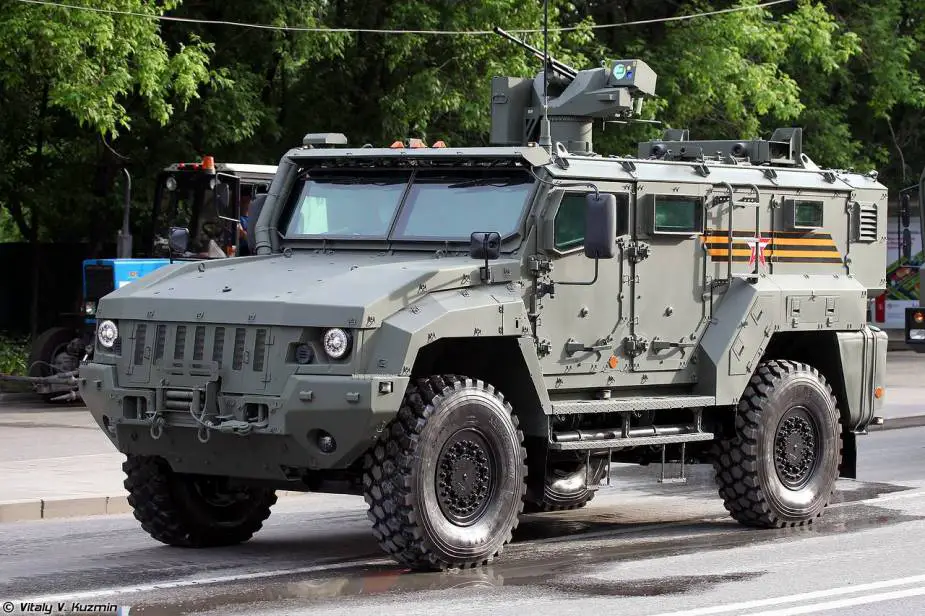
Kamaz-53949 4x4 Typhoon-K with Arbalet RWS Remote Weapon Station (Picture source: Vitaly Kuzmin)
Kamaz-53949 4x4 Typhoon-K with Arbalet RWS Remote Controlled Weapon Station
The second variant of Kamaz-53949 Typhoon-K at the Victory Day 2020 military parade is fitted with a remote weapon station Arbalet-DM armed with a 6P49 KORD 12.7mm caliber heavy machine gun.
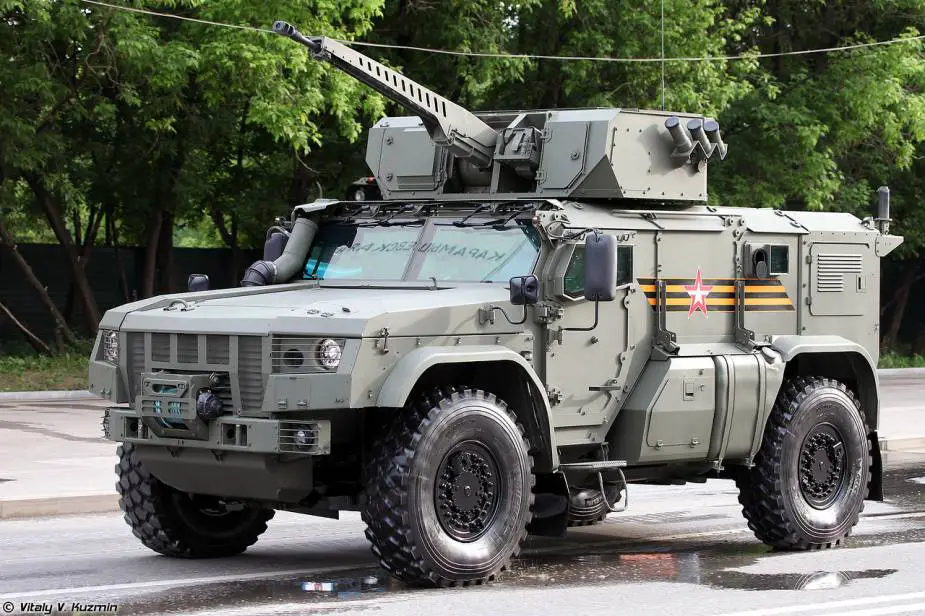
K-4386 Typhoon-VDV light 4x4 armored vehicle personnel carrier (Picture source: Vitaly Kuzmin)
K-4386 Typhoon-VDV
The K-4386 Typhoon-VDV was developed and designed by the Russian companies JSC “Plant of special vehicles” and Kamaz. The vehicle is motorized with a KAMAZ 610.10-350 diesel engine developing 350 hp. It can reach 105 km/h, with a maximum cruising range of 1,200 km.
The hull of the K-4386 is made of composite ceramic and steel armor, which provides ballistic protection against 14.5mm armor-piercing bullets all-around the vehicle, and mine blast protection from 8 kg TNT explosion under the wheels. It has a monocoque structure with an integrated V-shaped armor hull that protects occupants by deflecting mine blasts under the vehicle.
The K-4386 Typhoon-VDV at the Victory Day military parade 2020 is fitted with a BM-30-D unmanned turret armed with a 30mm 2A42 automatic cannon, a 7.62mm PKTM coaxial machine gun, and six smoke grenade launchers. The optoelectronic suite installed above the main gun includes a day/night vision, infrared cameras, and a laser rangefinder.
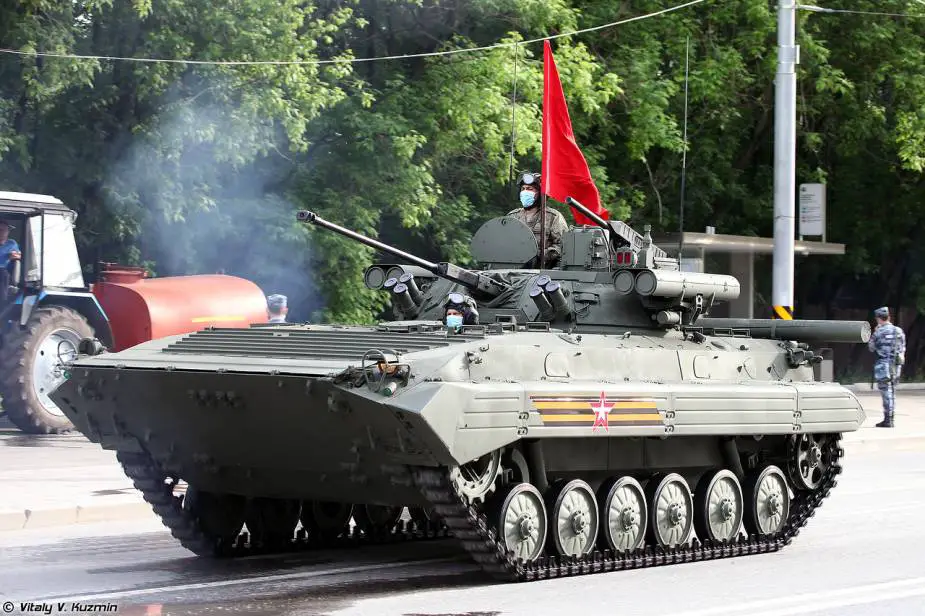
BMP-2M with Berezhok turret armored IFV Infantry Fighting Vehicle (Picture source: Vitaly Kuzmin)
BMP-2M Infantry Fighting Vehicle with Berezhok turret
The BMP-2M "Berezhok" is an upgraded version of the Soviet-made BMP-2 tracked armored IFV (Infantry Fighting Vehicle) with the same two-man turret as the standard BMP-2 armed with a stabilized 30mm cannon 2A42 and a 7.62mm PKT coaxial machine gun mounted to the left of the main armament, but new weapons are mounted on the turret, like a 30mm AG-17 automatic grenade launcher and four launchers of 9M133 Kornet series anti-tank guided missiles.
Compared to the baseline BMP-2, the Berezhok is equipped with a far better sensor suite. The turret has received an automatic target tracker and a ballistic computer. According to KBP, the module fires up to two missiles in salvo mode in order to score higher hit probability.
The BMP-2M "Berezhok" is fitted with the standard BMP-2 torsion bar suspension consisting of six roadwheels on each side, with the drive sprocket at the front, idler wheel at the rear and three track return rollers. The upper part of the suspension is protected by armor plates. The vehicle can carry a total of 9 military personnel: driver, gunner, commander and 6 infantrymen.
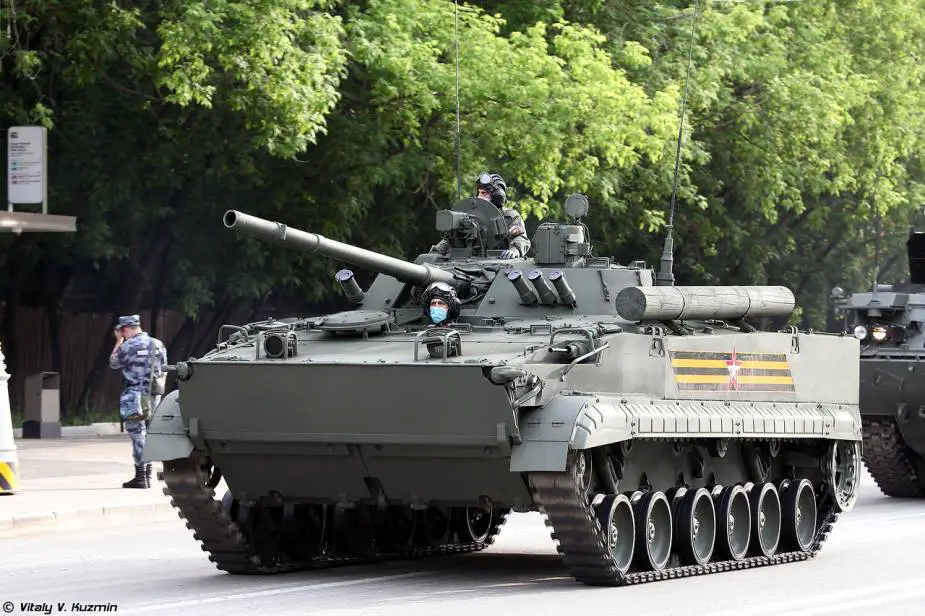
BMP-3 IFV Infantry Fighting Vehicle (Picture source: Vitaly Kuzmin)
BMP-3 IFV Infantry Fighting Vehicle
The BMP-3 is a Soviet-era tracked amphibious infantry fighting vehicle, the successor to the BMP-1 and BMP-2, which entered service with the Soviet army in 1990 and made its first public appearance the same year. The main armament of the BMP-3 is a 100mm 2A70 semi-automatic rifled gun/missile launcher, stabilized in two axes, that can fire either 3UOF HE-FRAG rounds or 3UBK10 anti-tank guided missiles.
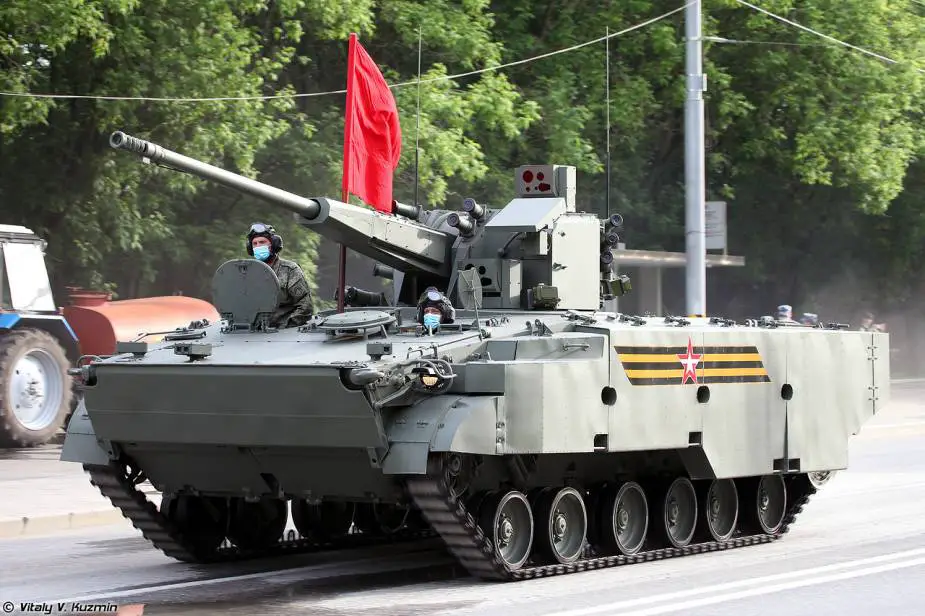
2S38 Derivatsiya 57mm self-propelled anti-aircraft tracked armored (Picture source: Vitaly Kuzmin)
2S38 Derivatsiya-PVO tracked self-propelled anti-aircraft armored vehicle
The 2S38 Derivatsiya PVO is a new Russian Self-Propelled Anti-Aircraft Gun (SPAAG) based on the tracked chassis of the BMP-3 IFV (Infantry Fighting Vehicle). It is designed to engage low-flying aircraft, helicopters, UAVs, cruise missiles, air-to-ground missiles.
The Derivatsiya is fitted with a remotely-controlled weapon station armed with a 57mm automatic cannon. The second armament consists of a 7.62mm machine gun mounted to the right side of the turret. The vehicle is fitted with a passive detection and tracking systems. It uses its thermal sight rather than radar to detect and track air targets. It can detect aerial targets at ranges of 12,300 m depending on the detection mode, and UAVs at a maximum range of 4,900 m. The 57mm cannon has a maximum firing range of 6,000 m.

Kurganets-25 with Epokha turret armored IFV (Infantry Fighting Vehicle (Picture source: Vitaly Kuzmin)
Kurganets-25 with Epokha turret
The Kurganets is a new tracked armored IFV (Infantry Fighting Vehicle) developed by the Russian Defense industry. The first version was fitted with a turret armed with the 2A42 30mm automatic cannon. A 7.62mm coaxial PKT machine gun is mounted to the left side of the main armament.
The new version showcased at the Victory Day Military parade 2020 is fitted with the Epokha turret, a remotely controlled weapon station armed with a 30mm automatic cannon, a 7.62mm coaxial machine and two launchers for Kornet anti-tank guided missiles mounted on each side of the turret.
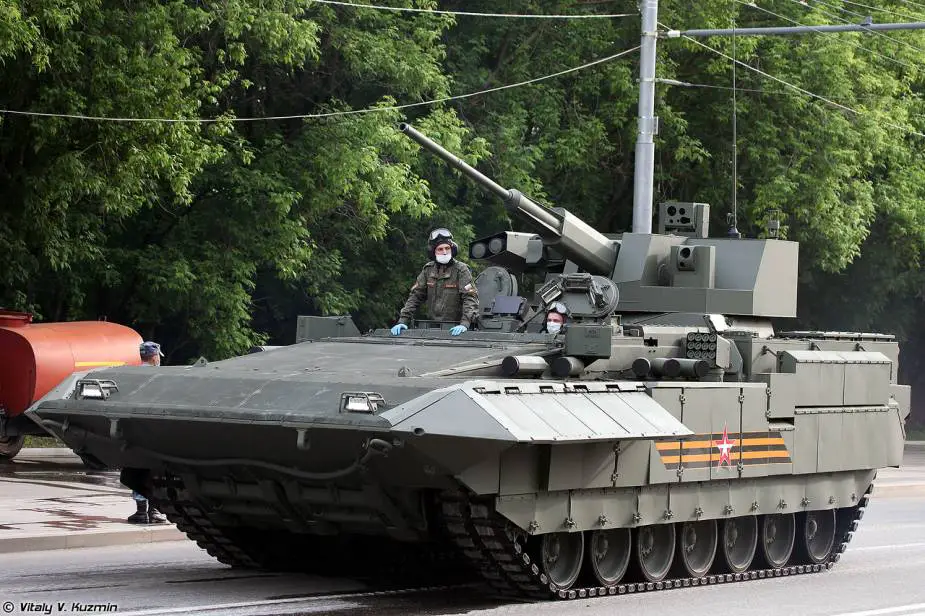
T-15 57mm armored IFV Infantry Fighting Vehicle (Picture source: Vitaly Kuzmin)
T-15 57mm cannon
The T-15 is a new generation of Russian tracked armored IFV (Infantry Fighting Vehicle). Initially, the T-15 was armed with a 30 mm 2A42 automatic cannon as the main armament, but at the Victory Day Military Parade 2020, the T-15 appeared fitted with a remotely operated weapon station armed with a 57 mm automatic cannon.
The 57 mm cannon is also mounted on the 220M Baikal remotely operated weapon station. The new 57mm is based on a modified S-60 towed anti-aircraft gun. It has a range of 14.5 km with a maximum rate of fire of 80 rounds per minute. The ammunition stock comprises 80 shells and includes 57mm projectiles including multirole ammunition with remote contact detonation, armor-piercing, and guided rounds able to destroy small drones, low-flying jets and helicopters, as well as light armor and field fortifications.
The second armament of the T-15 shown at Army-2018 also included a remotely operated weapon station armed with a 7.62mm machine mounted to the right side of the main armament, as well as two Ataka anti-tank guided missiles. The Ataka is an anti-tank missile with much-improved performance over the older AT-6 Spiral. It has a maximum firing range of 6 km and the tandem warhead could provide penetration of 800 mm armor.
The T-15 with 57mm cannon has the same level of protection as the T-14 Armata with a modular armor system made of steel, ceramics and composite materials. It offers up to STANAG 4569 Level 5 protection. Its forward section and hull sides are covered with reactive armor. It can be also fitted with additional active and passive armor. The new Afganit hard-kill active protection system is also mounted on the T-15 57mm to defend the vehicle against incoming anti-tank guided missiles (ATGMs), rockets and RPGs.
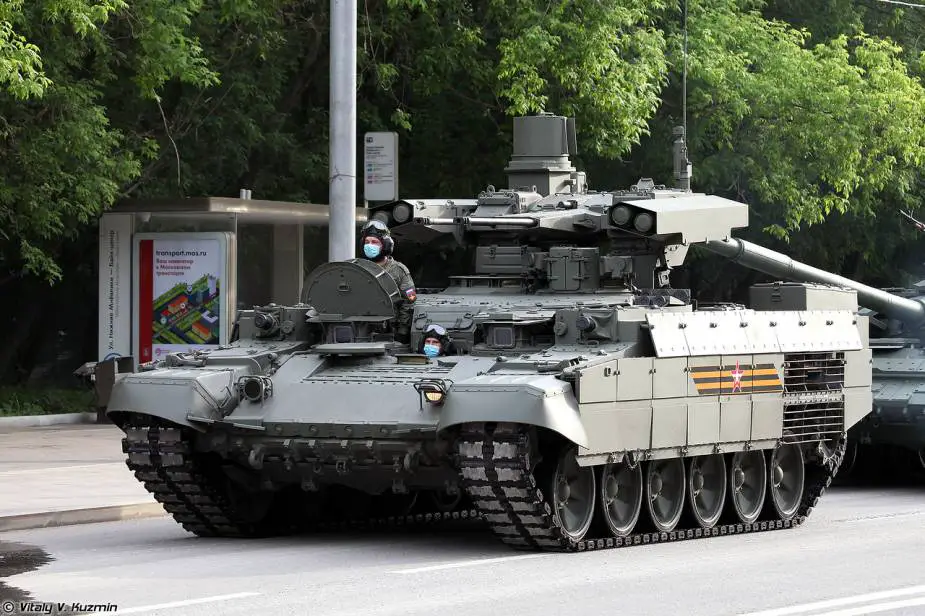
BMPT-72 fire support tracked armored vehicle (Picture source: Vitaly Kuzmin)
BMPT-72
The BMPT-72 (Terminator-2) fire support vehicle is based on the chassis of the T-72 MBT. According to the official catalog of the UVZ corporation, it has a full weight of no more than 44 tons (+2%), an overall length of 7.20 m, an overall width of 3.60 m, and an overall height of 3.20 m. The vehicle has a crew of three: driver, commander, and gunner. It has a maximum road speed of 60 km/h and a cruising range of 550 km (with external fuel tanks). The vehicle's armament suite incorporates two 30 mm 2A42 coaxial automatic cannons with an ammunition load of 850 rounds, a semi-automatic laser beam-guided missile system with four ready-to-launch ATAKA anti-tank guided missiles with a maximum firing range of 6 km and a 7.62 mm Kalashnikov PKTM machinegun with an ammunition load of 2,100 cartridges.
According to the manufacturer, the 2A42 30mm cannons have an effective range of 1,500 m against ground targets such as light armored vehicles, while soft-skinned targets can be engaged out to 4,000 m. Air targets can be engaged flying at low altitudes of up to 2,000 m at subsonic speeds and up to a slant range of 2,500 m.

T-72B3M MBT Main Battle Tank (Picture source: Vitaly Kuzmin)
T-72B3M Main Battle Tank
The T-72B3M, also called T-72B4, is an upgraded version of the T-72B3 which is the latest modernized version of the T-72. The T-72B3M project was unveiled to the public during the Final of International Russian army Tank Biathlon competition held in October 2014. According to Russian military engineers, the T-72B3M is comparable to the most advanced T-90, but at a much lower cost.
The main armament of the T72B3M / T-72B4 consists of a 2A46M5 125-mm smoothbore gun which is a modernized variant of the standard 2A46M cannon, also known as the D-81TM. This gun system features reduced recoil and a stabilized gun mount. The cannon can also fire 9M119 Refleks (NATO designation AT-11 Sniper) anti-tank guided missile system.
The layout of the T-72B3M / T-72B4 is similar to the standard T-72 with driver's at the front, fighting compartment in the center, and power pack at the back. The tank has a crew of three, with the driver seated at the front center of the hull. The other two crew members are seated in the turret, with the gunner on the left and the commander on the right.
The T-72B3M is protected with the new Relikt explosive reactive armor. It will replace the old Kontakt-5 system and is expected to be two times more effective. Developed by NII Stali, Relikt utilizes a completely new composition of explosives to achieve dynamics protection.
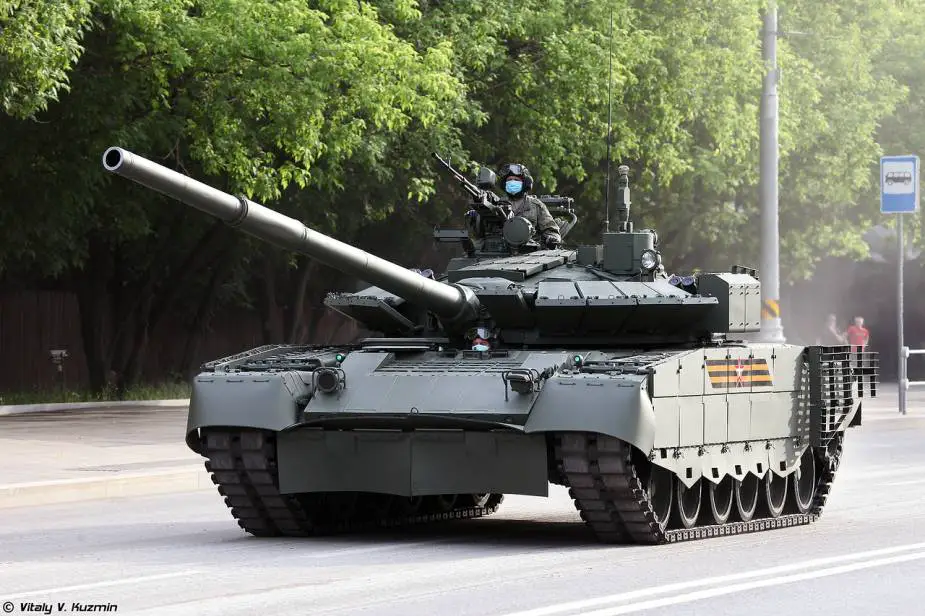
T-80 BVM MBT Main Battle Tank (Picture source: Vitaly Kuzmin)
T-80BVM
The T-80BVM is an upgraded version of the T-80BV tank. It has a multi-channel sight, a 125mm 2A46M1 gun, a 12.7mm NSVT antiaircraft machine gun, and a 7.62mm PKT coaxial machinegun. The ammunition load comprises 45 gun rounds, 300 12.7mm cartridges, and 1,250 7.62mm cartridges. It also has Refleks 9K119 missiles (NATO reporting name:: AT-11 Sniper). The tank is equipped with a gun stabilizer and an observation device.
The T-80BVM has an upgraded GTD-1250TF gas-turbine engine developing 1,250 hp. The tank can reach 70 km/h (43 mph), with a maximum range of 500 kilometers (311 miles). It has better maneuverability and mobility and is equipped with devices that increase its combat effectiveness, protection level and reliability in extreme conditions. The new engine improves the tank’s running characteristics, especially in harsh Arctic conditions.
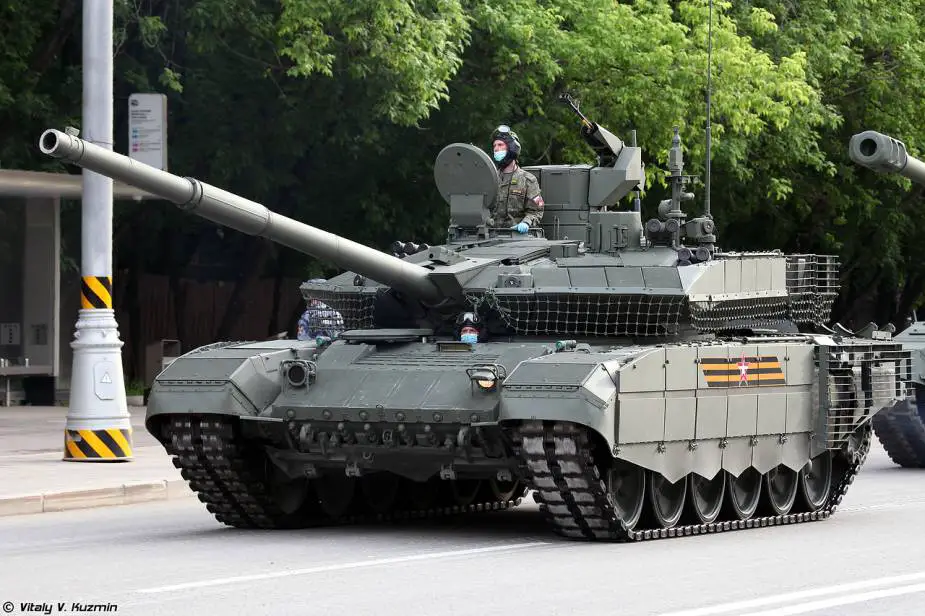
T-90M MBT Main Battle Tank (Picture source: Vitaly Kuzmin)
T-90M
The T-90M model 2017, also nicknamed Proryv-3, is an upgraded variant of the export version of the T-90MS Main Battle Tank (MBT) developed and designed by the Russian company Uralvagonzavod. The T-90M Model 2017 has been improved in terms of protection, mobility and firepower.
The main armament of the T-90M Model 2017 Proryv-3 consists of a 125 mm 2A46M-4 smoothbore gun able to fire standard ammunition but also anti-tank guided missiles (ATGM) Refleks (NATO Code AT-11 Sniper-B). The main 125 mm armament is stabilized and enables the T-90M to shoot on the move with a high probability of a first-round hit. The secondary armament includes a PKT 7.62mm coaxial machine mounted to the right of the main armament and, behind the commander's hatch, a remotely operated weapon station armed with an NSVT 12.7mm heavy machine gun.
The layout of the T-90M Model 2017 Proryv-3 is similar to all the family of Russian T-90 MBTs: driver at the front, turret in the center and power pack at the back. The T-90M features a new all-welded turret design protected by the Relikt ERA (Explosive Reactive Armour) fitted on the front and the turret. sides It features higher protection performance and serviceability compared with the Kontakt-5 ERA suite.
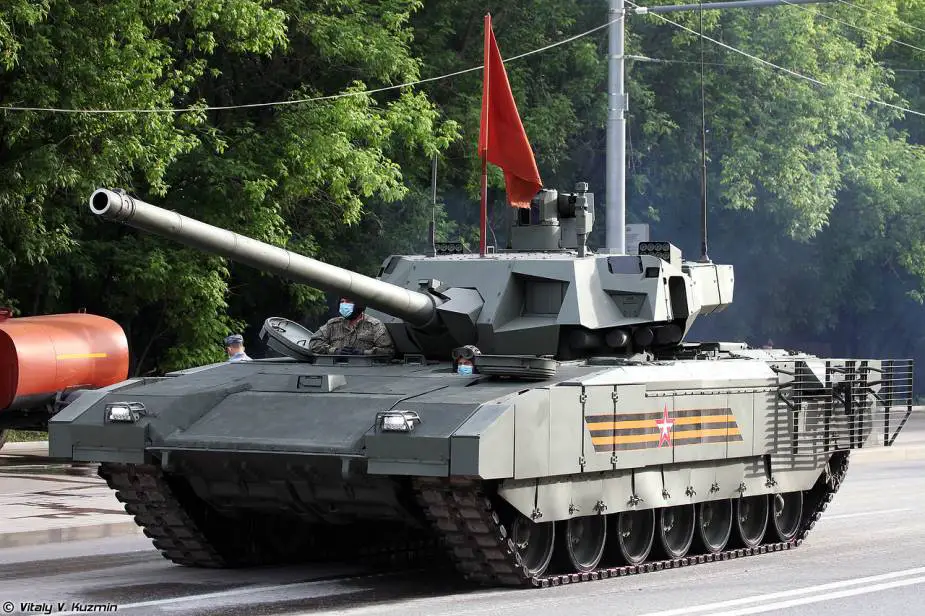
T-14 Armata MBT Main Battle Tank (Picture source: Vitaly Kuzmin)
T-14 Armata MBT Main Battle Tank
The T-14 Armata is the newest Russian main battle tank. It was unveiled to the public during the military parade held in Moscow for the Victory Day 2015 (May 9). The T-14 Armata is equipped with an unmanned turret: the 3-man crew is placed at the front of the hull. The unmanned turret is armed with a new generation of 125mm 2A82-1M smoothbore gun fed by an automatic loader. 32 rounds ready to use. The main gun can also fire a new laser-guided missile with a range from 7 to 12 km.
The T-14 Armata is equipped with the Afghanit APS (Active Protection System) which seems similar to the Israeli Trophy. It can intercept and destroy incoming missiles and rockets. The system is designed to work against all types of anti-tank missiles and rockets, including handheld weapons such as rocket-propelled grenades. The Afghanit APS includes four sets of 12 launch tubes: two at the rear-left side of the turret, and one on each rear-top side of the turret. At the base of each side of the turret are five large and horizontally fixed arrayed launch tubes covering the 120° frontal arc of the turret. These tubes can launch unguided projectiles with HE warhead to counter incoming anti-tank guided missiles or RPG (Rocket-Propelled Grenade).
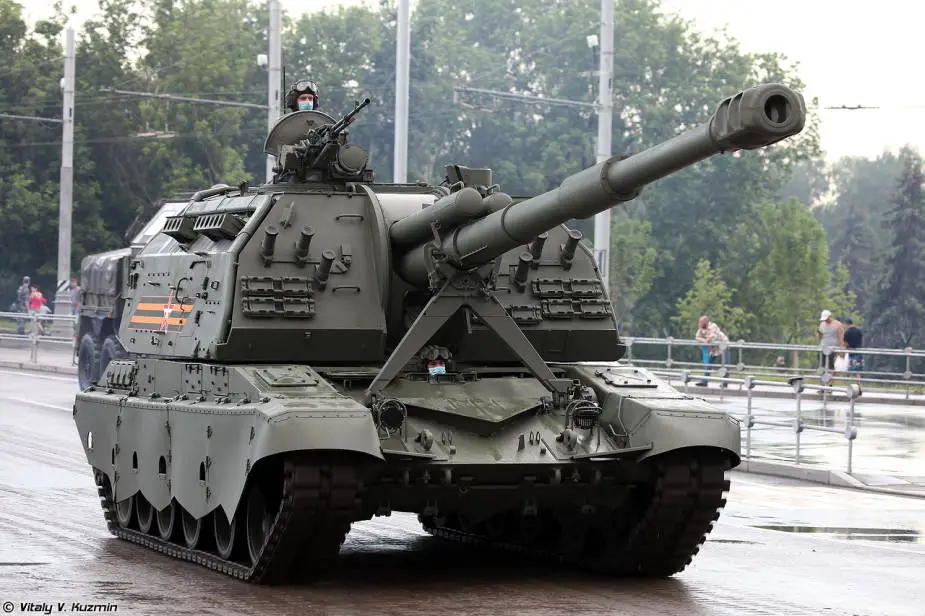
2S33 152mm self-propelled tracked howitzer (Picture source: Vitaly Kuzmin)
2S33 2S19M2 MSTA-SM2
The 2S33 MSTA-SM is an improved version of the 2S19 MSTA-S 152mm tracked self-propelled howitzer armed with a new 2A79 152mm cannon that has a greater range of fire. The 2S33 howitzer has now a range of more than 40 km, compared to the 2S19 that has a maximum firing range of 25 km.
The 2S19M2 is fitted with an upgraded aiming and fire-control system offering more accuracy and allows the crew to hit targets at a rate of fire of up to 10 rounds per minute.

2S35 Koalitsiya-SV 152mm self-propelled tracked armored howitzer (Picture source: Vitaly Kuzmin)
2S35 Koalitsiya-SV 152mm self-propelled howitzer
The 2S35 Koalitsiya-SV is a new generation of Russian-made self-propelled tracked howitzer based on the 2S19 chassis, fitted with a new turret. The 2S35 Koalitsiya-SV tracked self-propelled howitzer is armed with a new 2A88 152mm cannon that is under development. The 2S35 is able to fire a new generation of 9K25 shell, the 152 mm Krasnopol laser-guided projectile that has a maximum range of 20 km.
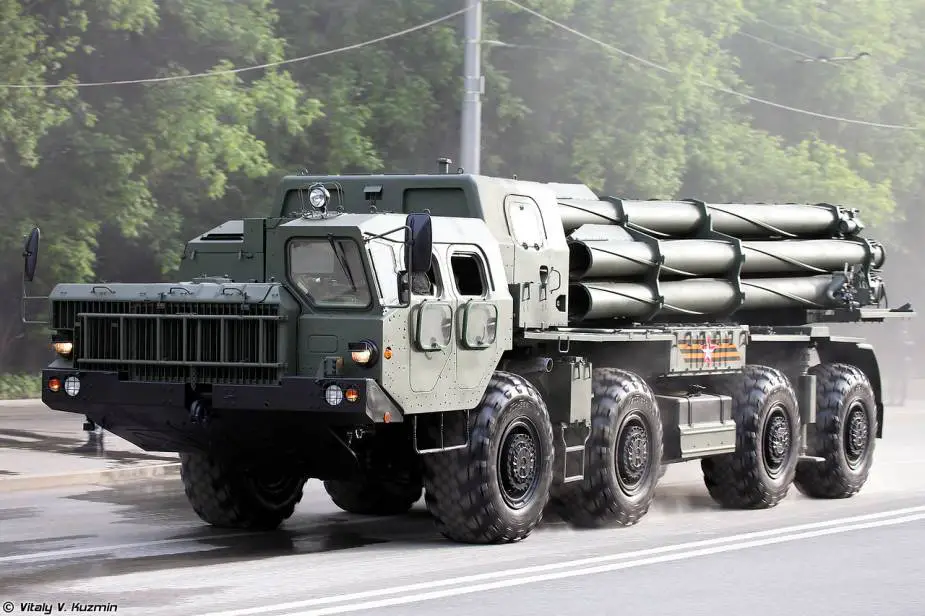
Tornado-S 9K515 300mm MLRS Multiple Launch Rocket System (Picture source: Vitaly Kuzmin)
Tornado-S MLRS Multiple Launch Rocket System upgraded BM-30
The Tornado-S is a modernized version of the BM-30 Smerch fitted with a Glonass antenna mounted on the cabin crew. Like for the modernized version of the BM-21, the Tornado-G, the upgraded version of the BM-30 is equipped with a satellite guidance system using the GLONASS system (equivalent to the U.S. GPS, Chinese Beidu (just operational now) and future European Galileo). The weapon system is equipped with an automated fire control system, along with the GLONASS autonomous satellite navigation and positioning system. It can fire rockets at a range from 25 to 70 km.
The BM-30 Smerch 9K58 launcher vehicle is equipped with 12 launcher tubes. The 300 mm rocket tube arrangement consists of two separate banks of four tubes with a connecting roof of the remaining four tubes overlying the inner tubes of the banks.
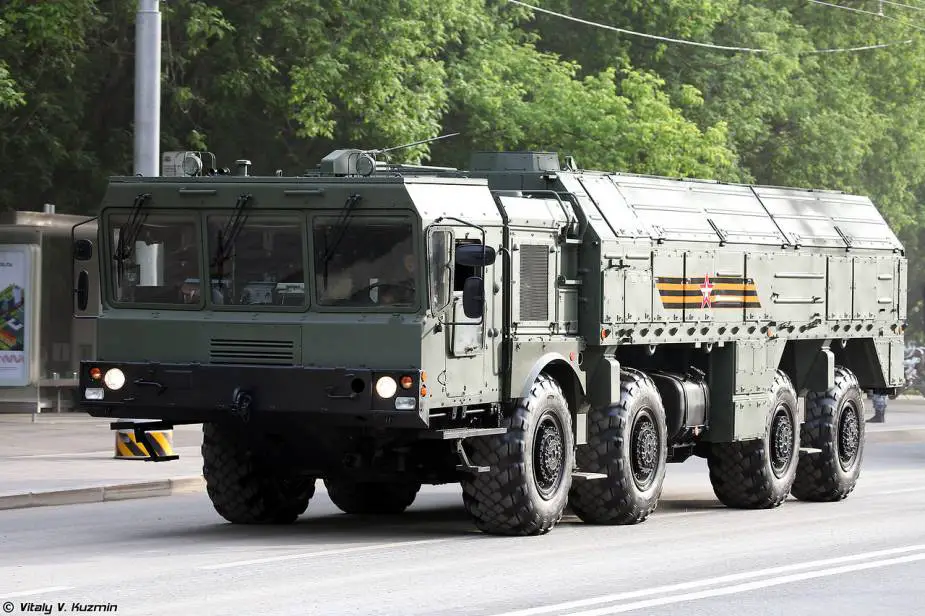
Iskander-M 9P78-1 TEL Transporter Erector Launcher unit. (Picture source: Vitaly Kuzmin)
Iskander-M 9P78-1 TEL Transporter Erector Launcher unit
Iskander-M Missile SS-26 Stone is a short-range tactical missile system developed and produced in Russia. The system replaces the Oka SS-23 SPIDER which had been terminated under the Intermediate Nuclear Forces (INF) Treaty. The development of the system was undertaken by the Kolomna Engineering Design Bureau development during the 1990s under the project name "Tender". The Iskander-M has a range of 400 km, with a potential for extension to 500 km, which is claimed by NATO to be a violation of the INF Treaty.
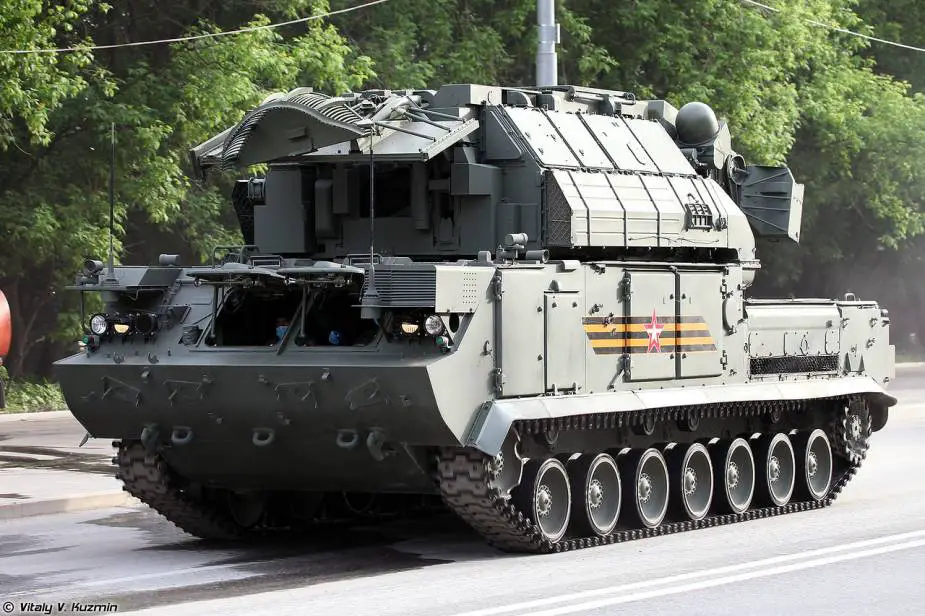
TOR-M2U 9A331M TLAR 9K331M air defense missile system (Picture source: Vitaly Kuzmin)
TOR-M2U 9A331M TLAR 9K331M
The TOR-M2U is an upgraded version of the TOR-M2 short-range air defense missile system. The TOR-M2U benefits from a new battlefield missile system with better algorithms to recognize, classify and prioritize targets, and able to engage four threats simultaneously. The TOR-M2U can destroy moving targets within a range of 12 km and at altitudes from 10 to 1,000 meters.
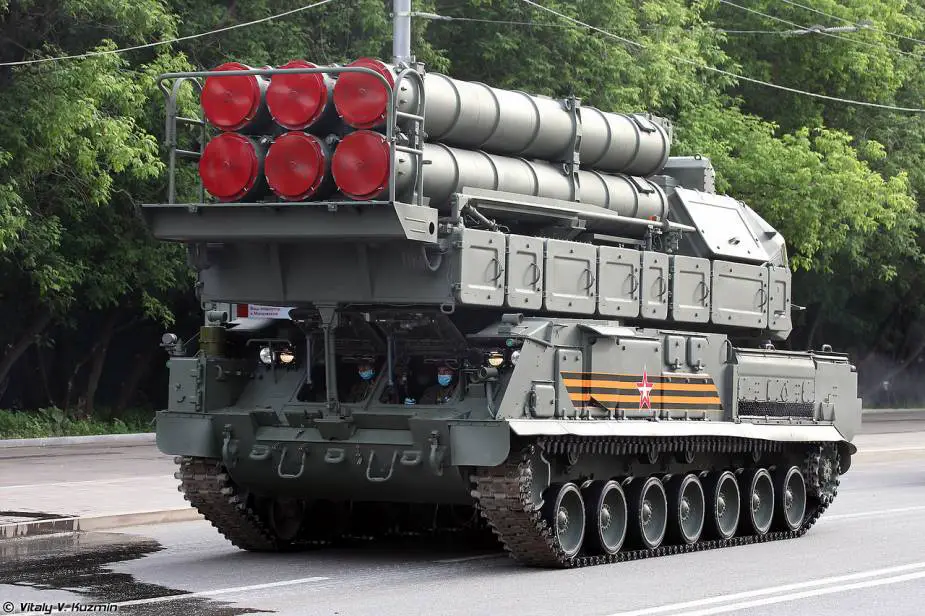
Buk-M3 Viking air defense missile system on armored tracked chassis (Picture source: Vitaly Kuzmin)
Buk-M3 Viking air defense missile system
The Buk-M3 medium-range surface-to-air missile system, also nicknamed Viking, is a modernized version of the Buk-M2, featuring advanced electronic components and a deadly new missile. It should be regarded as a completely new system. It has been designed, developed and manufactured by the Russian defense company Almaz-Antey.
A Buk-M3 Viking missile battery consists of two TELAR 9A317M (Transporter Erector LAuncher and Radar) and one TEL 9A316M (Transporter Erector Launcher) vehicle. The TELAR is based on the GM-569 tracked armored chassis. It carries six ready-to-fire missiles mounted on a turntable that can traverse a full 360°.
The Buk-M3 is able to destroy any type of air targets at a range of 2.5 to 70 km, with a speed of 3,000 m/s and at an altitude from 15 to 35 km. The Buk-M3 missile has been optimized for the interception of low-flying cruise missiles. It can also engage ground and sea targets.
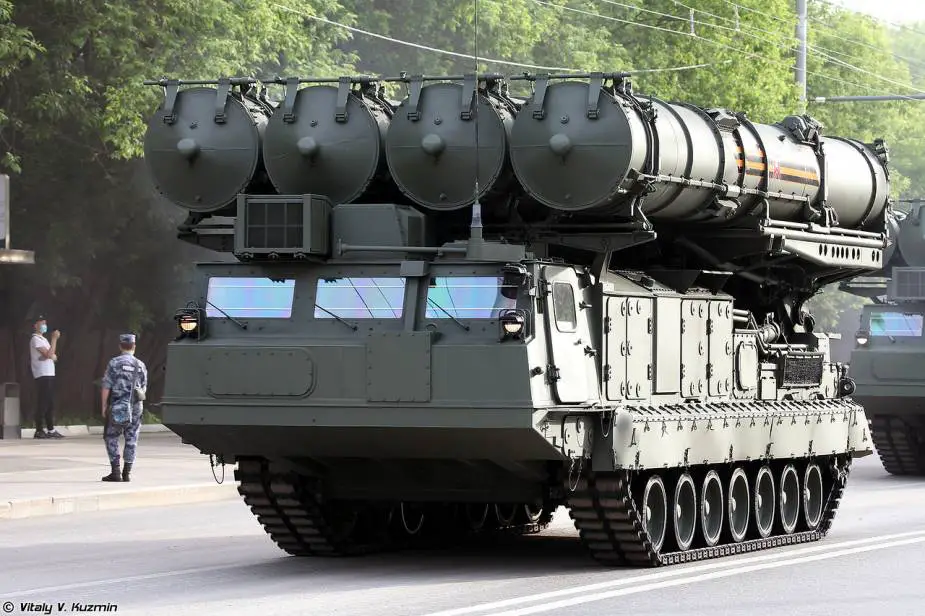
S-300V4 air defense missile system (Picture source: Vitaly Kuzmin)
S-300V4 9A83M
The S-300V4 is an improved version of the S-300V mobile air defense missile system derived from the S-300V3 incorporating technologies from the S-300VM (NATO designation: SA-23 Gladiator). The Russian Armed Forces planned to upgrade nine S-300V3 brigades to the S-300V4 standard by the end of 2020.
The S-300V4 is essentially a different SAM system. It is equipped with up-to-date digital radar control systems. The Russian Army equipped its first brigade with S-300V4s in 2014. The S-300V4’s arsenal was beefed up with these advanced SAMs in 2015. The new long-range missile travels at hypersonic speed (about 9,000 km/h) at up to 400 km for a kill, while the short-range SAM intercepts small fast hard-jinking targets within the 150-km radius.
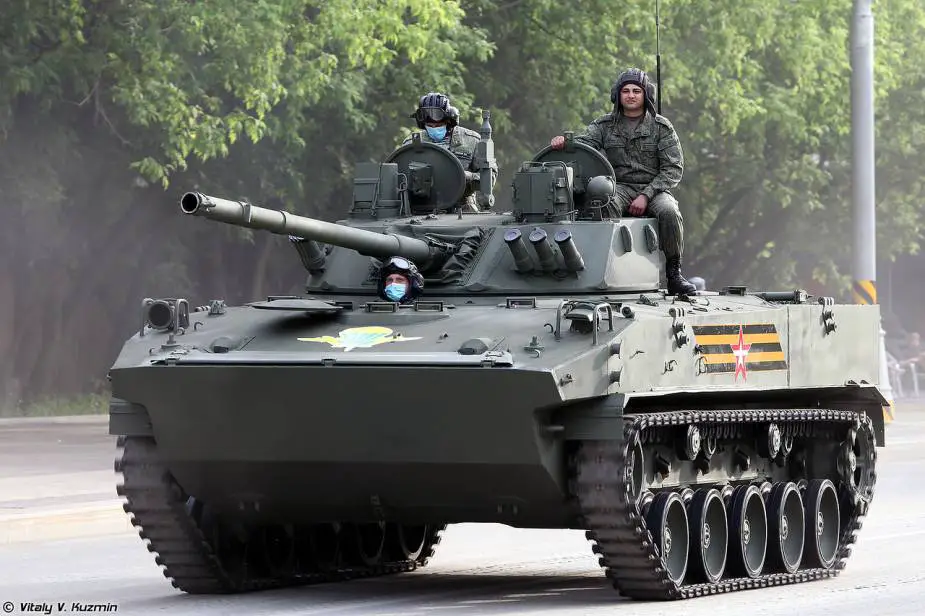
BMD-4M airborne armored IFV Infantry Fighting Vehicle (Picture source: Vitaly Kuzmin)
BMD-4M airborne tracked IFV Infantry Fighting Vehicle
The BMD-4M is the latest generation of Russian-made airborne armored infantry fighting vehicle that can be air-dropped to provide firepower and support for airborne troops. It is an upgraded variant of the BMD-4 (BMD-3M). The BMD-4M is fitted with a two-man turret armed with a 2A70 100mm caliber gun, coupled to a 30mm 2A72 cannon and a 7.62mm PKT coaxial machine gun mounted to the right of the main armament. The 100mm gun uses an automatic loader with 34 rounds of 100mm ready-to-fire and 18 in reserve.
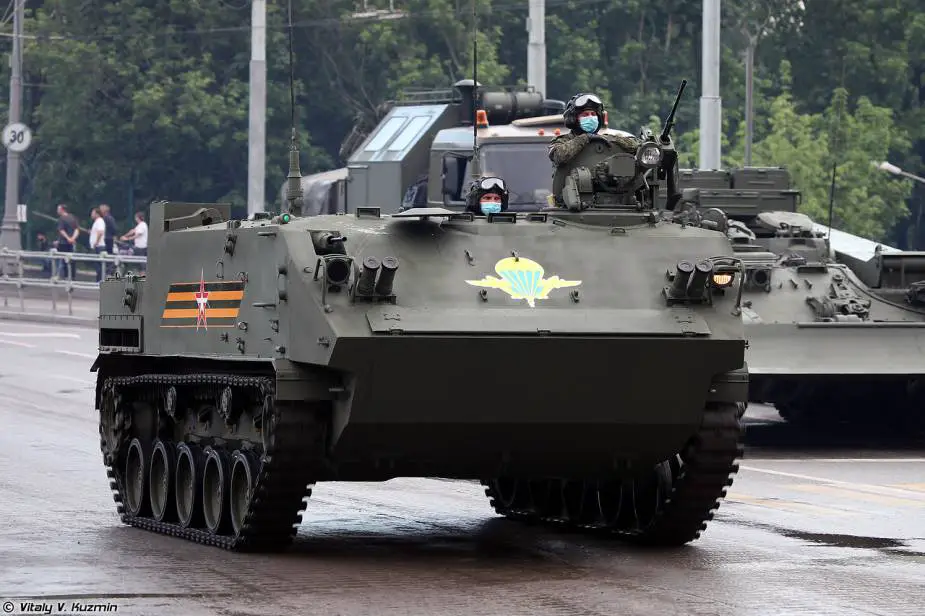
BTR-MDM Rakushka airborne multi-role armored vehicle (Picture source Vitaly Kuzmin)
BTR-MDM airborne tracked multi-role armored
The BTR-MDM Rakushka is a further development of the BTR-MD airborne multi-role armored vehicle. The BTR-MDM was unveiled during the 9th International Exhibition of Arms, Military Equipment and Ammunition Russian Arms Expo 2013 that was held from 25 - 28 September 2013 in the city of Nizhny Tagil, Russia.
The BTR-MDM is of all-welded aluminum construction, providing the crew with protection from small arms fire and shell splinters. The crew consists of commander, driver and 13 seats for military personnel.
The BTR-MDM Rakushka is equipped with a remote weapon station mounted to the top left side of the hull, armed with a 7.62mm or 12.7mm machine gun. Another 7.62mm machine gun is mounted at the front right side of the hull. Two smoke grenade dischargers are mounted to each side at the front of the vehicle.

TOS-1A flamethrower MLRS Multiple Launch Rocket System (Picture source: Vitaly Kuzmin)
TOS-1A flamethrower MLRS Multiple Launch Rocket System
The TOS-1A is a Russian-made heavy flamethrower system designed for the fire support of infantry and tanks, defeating enemy personnel in an unconcealed environment and under shelter in various kinds of offensive and defensive combat actions, and also for incapacitation of light armored transport and vehicles.
The armament of the TOS-1A consists of a block launcher with 24 guide pipes of 220 mm caliber for the launching of unguided rockets. The whole system is mounted on the center of a tracked armored chassis.
The TOS-1A fires an unguided rocket via a ballistic course after its boosting by a solid-fuel thrust engine. The projectile nose is equipped with a special thermobaric explosive. At the missile fuse activation on the target area, a central initiation-destructive charge destroys a thin-walled capsule of the projectile nose and dispenses thermobaric explosives

TOS-2 Tosochka Flamethrower Rocket Launcher vehicle. (Picture source: Vitaly Kuzmin)
TOS-2 flamethrower MLRS Multiple Launch Rocket System
The new TOS 2 Tosochka is based on an Ural-63706-0120 chassis. According to our first analysis, the front of the truck is fitted with an armored cabin that provides the crew with protection against small-caliber ammunition and artillery shell splinters.
The rear of the truck chassis is fitted with the launcher station that includes a container with three rows of eight rocket launcher tubes. According to Russian military sources, it can fire 220mm rockets with thermobaric and smoke-incendiary warheads. The vehicle is also equipped with an onboard computerized fire control system, inertial navigation, and aiming systems.
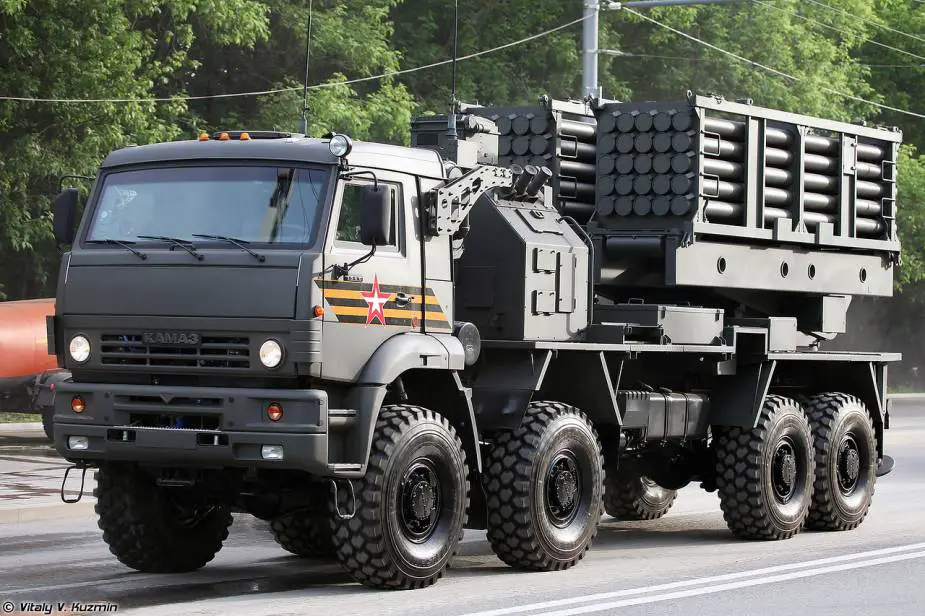
ISDM minelaying system launcher on Kamaz truck chassis (Picture source: Vitaly Kuzmin)
ISDM minelaying system launcher
The ISDM remote-controlled mine-laying engineering system includes combat vehicles with transporter-launcher containers with munitions and fused mines of various types, and also a transporter-loader vehicle. The ISDM system’s armament is mounted on a KamAZ chassis equipped with an armored cabin and an automatic weather station. The new system operates within a 5 to 15 km range. The launching containers optimized for using new-generation land mines have been developed for this ISDM system.
The ISDM fires an automatic salvo at designated target points, then records the explosion areas and transmits the data to higher command and control centers, and to the transporter-loader vehicle before reloading.

Pantsir-SM short-range cannon/missile air defense system (Picture source: Vitaly Kuzmin)
Pantsir-SM air defense system
The Pantsir-SM is a recent gun/missile air defense system in the family of Russian-made Pantsir (it was unveiled at Army-2019 defense exhibition near Kubinka). The vehicle is based on a KamAZ-53958 Typhoon-K 8x8 chassis. The front of the truck chassis is fitted with a fully enclosed armor cabin offering protection against firing of small arms and artillery shell splinter. The weapon system is mounted at the rear of the truck chassis.
The Pantsir-SM is superior to the Pantsir-S1 by 1.5-2 times. It incorporates a multi-functional targeting radar station, increasing target detection range from 40 to 75 km and engagement range from 20 to 40 km, thus twice more efficient than the current Pantsir-S1. The weapon station is fitted on a new KamAZ K-53958 8×8 chassis with armored cab.
The new Pantsir-SM incorporates a multi-functional targeting radar station, increasing the target detection range from 40 to 75 km and the engagement range from 20 to 40 km. It is able to destroy aerial targets at a maximum range of 40km and at a 15km altitude, twice more than the current Pantsir-S1. The new radar is able to detect targets at a distance of 75 km. The weapon station is mounted on a new 8x8 Kamaz truck chassis with armored.
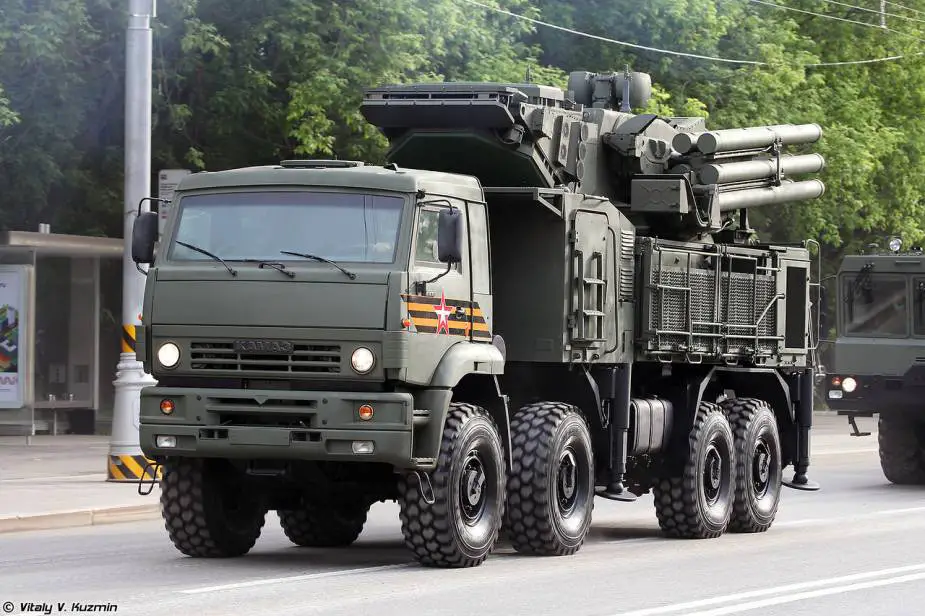
Pantsir-S1 short-range air defense system (Picture source: Vitaly Kuzmin)
Pantsir-S1 air defense missile/cannons system
The Pantsir-S1 (NATO code name: SA-22 Greyhound) is an air defense missile/gun system designed and manufactured by the Russian defense companies KBP Instrument Design Bureau and Ulyanovsk Mechanical Plant. The armament of the Pantsir-S1 consists of twelve 57E6 surface-to-air guided missiles and two 2A38M 30mm automatic guns developed from the twin-barreled 30mm GSh-30 gun. It is fitted with a multi-range radar capable of detecting aerial targets with an effective surface of dispersion of up to 2-3 square meters at a distance of more than 30 kilometers, and track them down from a distance of over 24 kilometers.

Pantsir-SA Arctic short-range air defense missile system (Picture source: Vitaly Kuzmin)
Pantsir-SA Arctic short-range air defense missile system
The Pantsir-SA is a new Russian-made short-range air defense missile system using the Pantsir-S1 weapon station. The system is specially designed to be used in the Arctic region. It is based on the chassis of the DT-30PM tracked all-terrain vehicle which consists of two tracked vehicle units linked by a steering mechanism.
The Pantsir-SA is fitted with a weapon station similar to the Pantsir-S1's but without the 30mm cannons. The main armament consists of 18 launchers for 57E6 surface-to-air guided missiles, nine in three rows on each side of the turret. The missiles can hit a target at a range of 1,200 to 20,000 m, at an altitude from 5,000 to 15,000 meters.
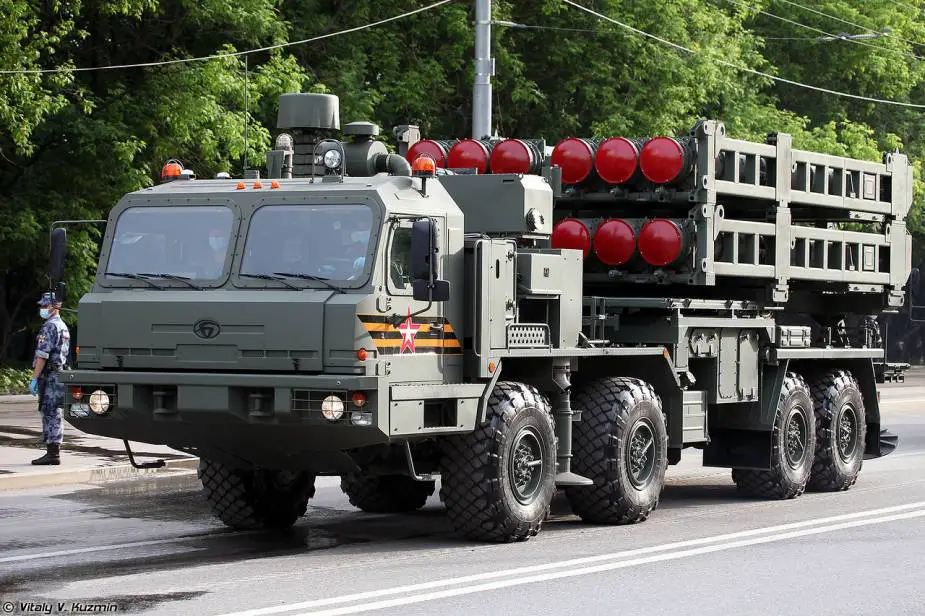
S-350 Vityaz surface-to-air defense missile system (Picture source: Vitaly Kuzmin)
S-350 Vityaz surface-to-air defense missile system
The S-350E Vityaz 50R6 is a new mobile ground-to-air defense system designed, developed and manufactured in Russia by the Russian defense company Almaz-Antey.
The S-350E Vityaz 50R6 missile system is mounted on an 8x8 truck chassis, under the technical name of 50P6. It's a dual missile system, whereby each of the standard containers can be replaced by a pack of four smaller and shorter weapons. The vertical launcher truck carries twelve tubular containers, in two lines of six.
The missile for the S-350E Vityaz 50R6 is the 9M96 guided missile which was originally designed for the S-400 system. This missile can be used against aerial and ballistic targets with a firing range from 1.5 to 120 km and at an altitude from 10,000 to 30,000 meters.
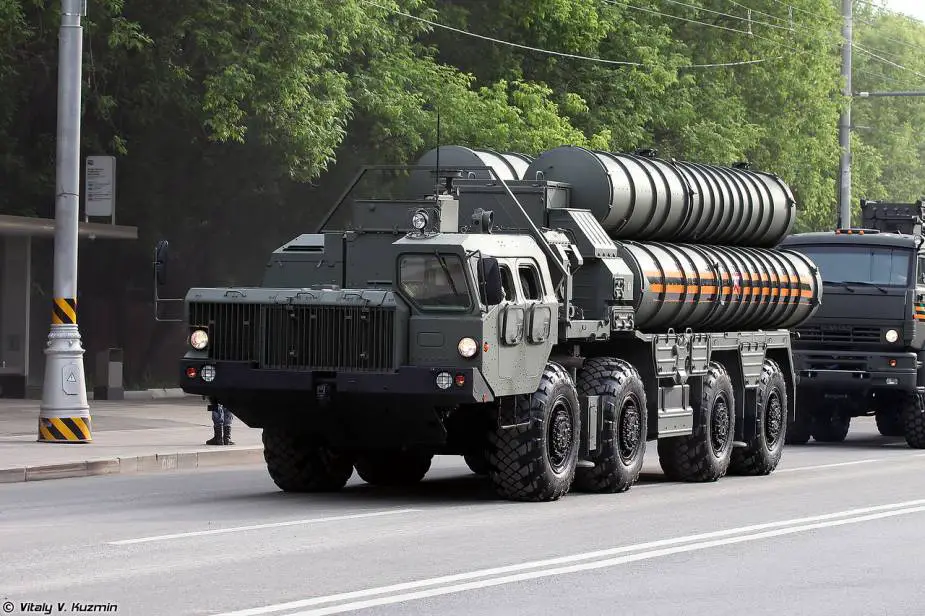
S-400 surface-to-air defense missile system (Picture source: Vitaly Kuzmin)
S-400 surface-to-air defense missile system
The S-400 Triumph is a long-range surface-to-air missile system produced by Almaz-Antey. The S-400 entered service with the Russian Armed Forces on April 28, 2007, replacing the S-300 air defense system. The possibility of using air defense missiles with various effective ranges ensures the system modular capability that makes it possible to set up layered air defense and non-strategic anti-missile defense systems. The S-400 missile has a maximum range of 400 km and can hit all air targets wit high accuracy.
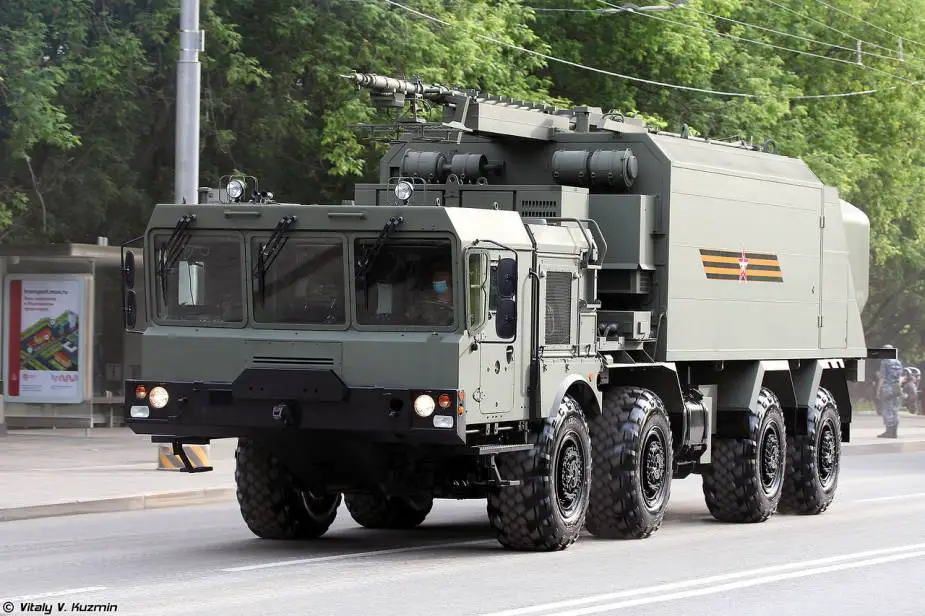
Bal anti-ship missile Command and Control vehicle (Picture source: Vitaly Kuzmin)
Bal anti-ship missile Command and Control vehicle
The Command and Control vehicle of the Bal anti-ship missile defense system is based on the MZKT-7930 8x8 truck chassis. The command center is fitted with a Garpun surface search radar. The Kh-35 missiles use inertial guidance and active radar homing in the terminal phase. The effective range of the missile's radar is around 20 km. Instead of the Bal command center, the Monolit-B active and passive over the horizon surface search system can also be used.
The command vehicle is fitted with a large NBC protected shelter.

Bal anti-ship coastal missile defense system (Picture source: Vitaly Kuzmin)
BAL anti-ship coastal missile defense system
The Bal is a Russian-made coastal defense missile system that uses Kh-35 anti-ship cruise missiles. The launcher vehicle is based on an MZKT-7930 heavy high-mobility 8x8 chassis.It carries 8 cylindrical containers with Kh-35 anti-ship cruise missiles.
The maximum range of the Kh-35 missile is 120 km. This sea-skimming missile flies at Mach 0.8. Since the missile is dependent on radar data, the range is limited to the effectiveness of the coastal radar systems. The 145 kg shaped charge high explosive warhead is effective against medium-size naval targets, such as frigates.
A Bal battery consists of a command vehicle, two missile launcher vehicles, and two transloaders. A coastal defense unit usually consists of two batteries. All the vehicles are based on the MZKT-7930 8x8 truck chassis.
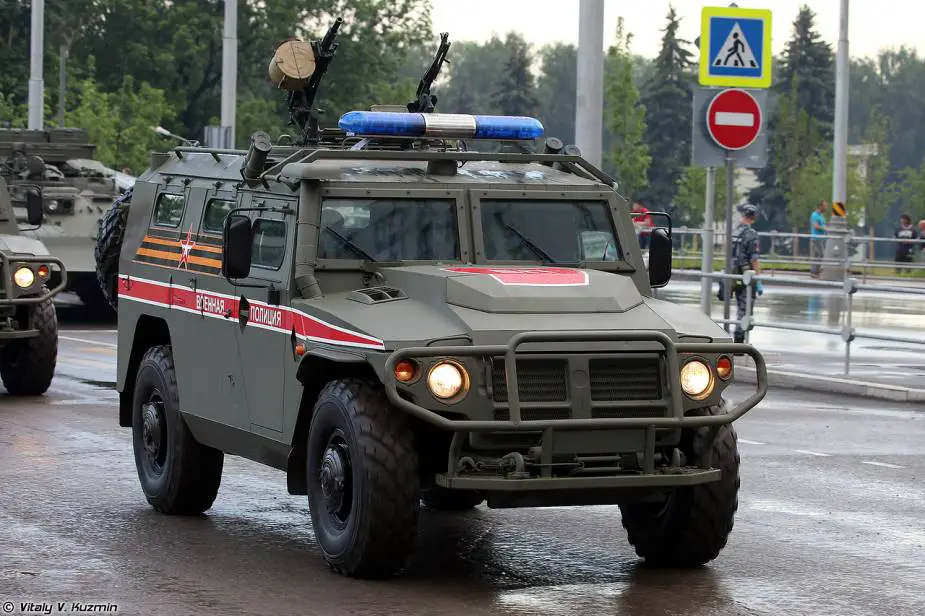
Tigr-M ASN 233115 4x4 tactical vehicle (Picture source: Vitaly Kuzmin)
Tigr-M ASN 233115 4x4 tactical vehicle
The Tigr-M ASN-233115 is a 4x4 armored tactical vehicle. It features a monocoque welded three-door hull that provides STANAG 4569 Level 1 protection against 5.56 mm and 7.62 mm bullets. The vehicle weighs some 8,000 kg and transports a payload of 1,200 kg or six fully equipped soldiers with individual weapons. The vehicle can carry additional armaments, such as a 6P41 Pecheneg.

Typhoon-K Kamaz-63968 6x6 armored personnel carrier (Picture source: Vitaly Kuzmin)
Typhoon-K KamAZ-63968 6x6 armored personnel carrier
KamAZ-63968 Typhoon also called Typhoon-K is a family of Russian multi-functional, modular, armored, mine-resistant (MRAP) vehicles. The Typhoon family is part of Russia's Typhoon program launched in 2010. Both KamAZ and GAZ-Group are taking part in the Typhoon program and develop their own family of vehicles. KamAZ-63968 6x6 Typhoon-K (Taifun) weighs 21 tonnes and can carry up to 16 people.
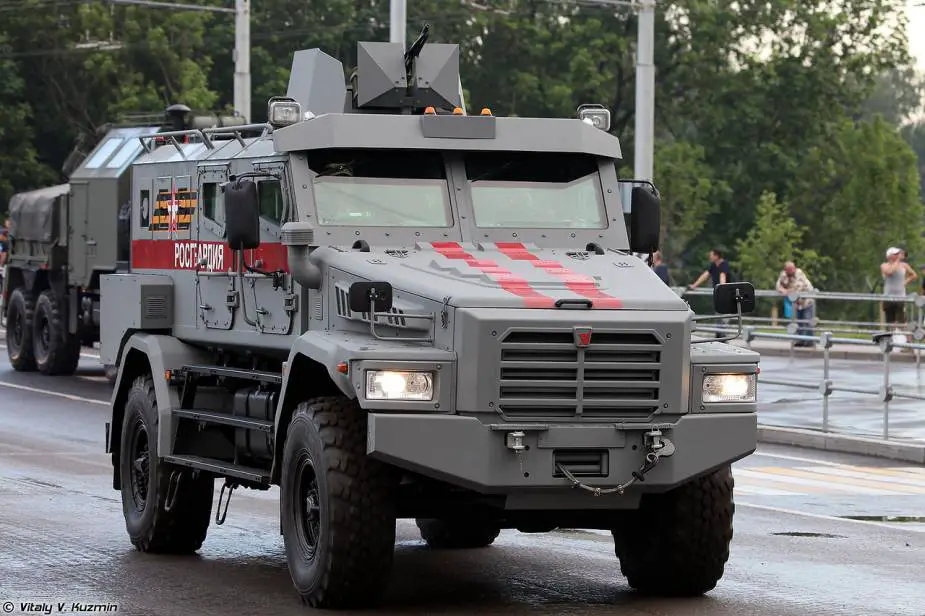
Patrol 4x4 armored vehicle (Picture source: Vitaly Kuzmin)
Patrol 4x4 armored vehicle
The Patrol is a 4x4 armored vehicle chassis based on that of the 4x4 KamAZ-43502 truck. The Patrol chassis has a conventional layout different from that of the baseline analog. The ACV accommodates 10 men and its basic armor protection meets Br4 GOST standard protection against 5.45 mm 7N10 rounds and 7.62 mm bullets fired from the Kalashnikov assault rifles.
The Patrol armored vehicle is designed for terrain patrol, reconnaissance and personnel transport. The combat vehicle outfit weighs 12.7 tons; the payload is 1.5 tons, personnel capacity is 10 men.
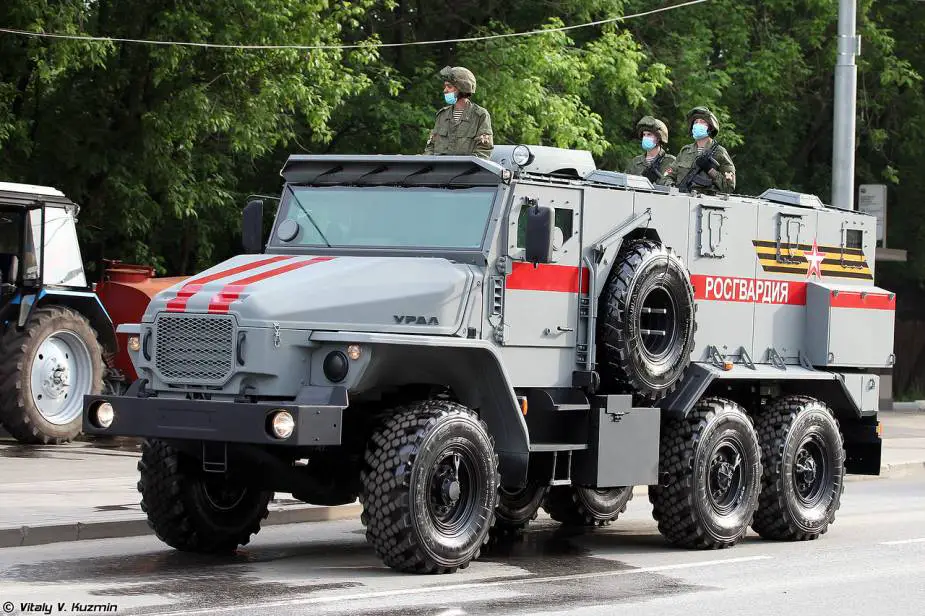
Ural-432009 Ural-VV 6x6 Armored Personnel Carrier (Picture source: Vitaly Kuzmin)
Ural-432009 Ural-VV 6x6 Armored Personnel Carrier
The Ural-VV is a 6x6 APC (Armored Personnel Carrier) vehicle based on a military truck chassis Ural-4320 fitted with an armored crew cab and troop compartment providing protection against small-caliber ammunition and artillery shell splinters. It has a crew of two (driver and commander). The rear part of the vehicle can accommodate 8 infantrymen. It can run at a maximum road speed of 90 km/h.

RS-24 Yars mobile ballistic missile launcher (Picture source: Vitaly Kuzmin)
RS-24 Yars mobile ballistic missile launcher
The Yars RS-24 Is a Russian-made mobile nuclear intercontinental ballistic missile mounted on a carrier truck or deployed in a silo. The first production of Yars began in 2004. The layout of the vehicle is similar to the Topol-M SS-27. The missile RS-24 is a three-stage, solid-propellant, MIRV-capable (Multiple Independently Targetable Reentry Vehicles) ICBM (InterContinental Ballistic Missile) with a range of 10,500 km. The missile uses the GLONASS guidance system used in the RS-12M2 (Topol-M SS-27) missile. The accuracy is expected to be around 250 meters CEP (Circular Error of Probability). RS-24 is supposed to have a minimum range of 2,000 km, and a maximum range of 10,500 km. The RS-24 missile can be armed with up to 10 MIRV warheads.
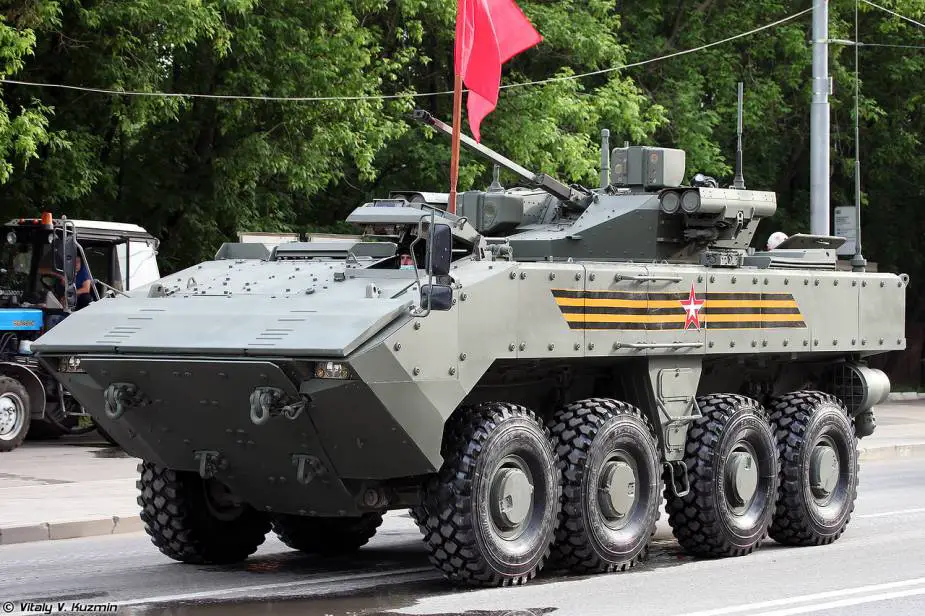
Bumerang K-17 8x8 IFV Infantry Fighting Vehicle (Picture source: Vitaly Kuzmin)
Bumerang K-17 8x8 IFV Infantry Fighting Vehicle
The K-17 Boomerang or Bumerang is a new development of 8x8 armored vehicle personnel carrier launched by the Russian defense industry to replace the old BTR family used by the Russian armed forces. During the International exhibition of arms and military equipment RAE 2013 in Nizhny Tagil, the project of the vehicle was shown only to the Prime Minister of Russia. The Bumerang K-17 is equipped with an electrically powered unmanned turret mounted in the center of the hull. The turret is armed with a 2A42 30mm automatic cannon. A 7.62mm coaxial PKT machine gun is mounted to the left side of the main armament. Two launchers of anti-tank guided missile Kornet-EM are mounted on each side of the turret.


























